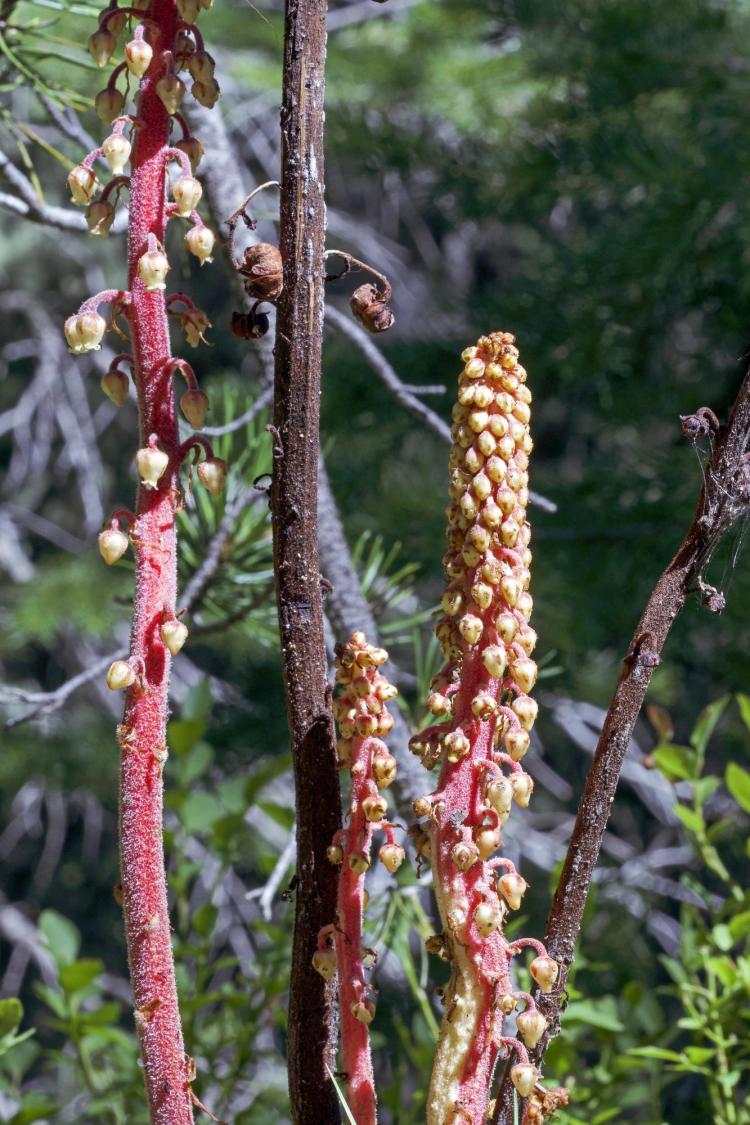A plant incapable of photosynthesis but good at forming bridges
Last summer I went to Chambers Lake, near Cameron Pass, to see its two outflows, a highly unusual and unstable distinction—most lakes have one outflow. An outflow to the north feeds the Laramie River, which flows into Wyoming, and an eastern outflow feeds Joe Wright Creek that flows into the Cache la Poudre. Regrettably, Chambers Lake is now highly managed and both outflows are buried in tall cement dams. However, I found a fascinating native wildflower.
Walking along the trail to Lost Lake I noticed a plant that had no green tissue. I inferred, from its lack of photosynthetic tissue, that it had to be parasitic and later I learned that this was pinedrops, Pterospora andromedea.
Pinedrops has reddish stems that one author described as bubble gum pink. Its stems are unbranched and usually between two and three feet tall, although one account reports stems taller than six feet. Some of the stems that I found were already dry and had turned brown and had shriveled, but had not toppled. Although I had not noticed leaves, pinedrops has vestigial leaves lacking chlorophyll that looked like spikes tightly appressed to the lower portion of the stems. The pink stems bore white flowers that resembled dangling urns.
Similar flowers are seen on blueberries, common manzanita, kinnikinnick and snow flower, all relatives in the family Ericaceae, the heath or heather family. The plant most closely related to pinedrops is the brilliant red, parasitic plant called snow plant or snow flower, Sarcodes sanguinea, which parasitizes the roots of trees. It is native to some mountain ranges in Oregon, California and Baja California.
Pinedrops is a parasite on the roots of pines, but the relationship is neither as simple nor as direct as that. The basal portion of pinedrops becomes associated with mycorrhizal fungi attached to the roots of pine trees. Ectomycorrhizal fungi and many species of trees are mutualists, partners in a mutually-beneficial relationship. The fungi increase the root area of the tree, enabling it to secure more minerals and water. In return, the fungus receives carbohydrates and nutrients from the tree.
Pinedrops seeds are tiny, dispersed by the wind, short lived, and difficult to germinate. Laboratory studies found that pinedrops seeds require a specific chemical that diffuses from a species of mycorrhizal fungus. As a seed develops into a plant, its roots become encased in fungal threads called hyphae.
Pinedrops parasitizes the mycorrhizal fungus directly, stealing water, minerals, carbohydrates and nutrients, but supplying nothing in return. In effect, it parasitizes a mutualism after germinating in the grasp of a fungus.
Three genotypes, or perhaps ecotypes of pinedrops are known. One genotype is found in New England and Michigan and Wisconsin, and it is quite rare and it appears to be on the border of local extinction in widely dispersed, tiny populations. Two genotypes are found in western states and both are common. It is important to note that each of these genotypes or ecotypes requires a different species of mycorrhizal fungus to germinate, grow and survive to maturity. The three fungal species are very closely related, but critically different from the perspective of pinedrops genotypes. The two western genotypes can be intermixed in a forest, but their association with their specific fungus is absolute. The problem with the dwindling populations in the east is suspected to lie in its absolute requirement of one species of fungus, which might be adversely affected by some change, such as habitat deterioration in the form of acid rain or the concomitant increase in soil acidity.
Although the association of pinedrops genotypes with fungal species is absolute, the association of mycorrhizal species with pine host species is much looser. A field study in California found both of pinedrops’ mycorrhizal species on the roots of bishop pine, Jeffrey pine, lodgepole pine, and sugar pine. A fussy pinedrops can only utilize a single species of mycorrhizal fungus, but that generalist fungus uses a variety of pine species for hosts. The pinedrops plant that inspired this column was growing beneath lodgepole pines.


